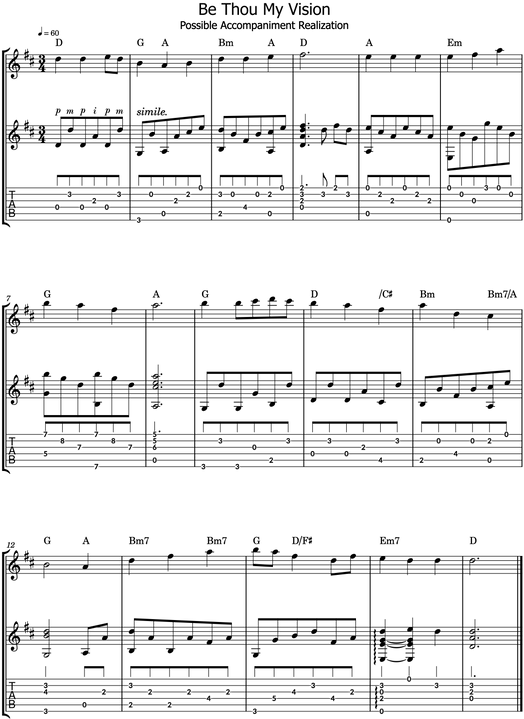It's Fingerpickin' Good!
Enhancing Worship Through Acoustic Technique
by Jahred Warkentin
As an acoustic guitarist leading or supporting worship, it can be easy to fall into strumming the same patterns you know so well and living in the mf - f dynamic range. After all, many of us have to sing and play so we don’t want to play anything too difficult for fear that we won’t be able to keep it up while singing. However, so often the most spiritually rich times in worship settings are in the soft, quiet moments. This is where the beautiful delicacy of the acoustic guitar in mp - p can really shine. The guitar was made for small environments. Its gentle nature is its charm, and we can bring that atmosphere into our corporate worship through fingerpicking. Using your fingers instead of a pick creates a warm and soft sound. It also allows you to alternate between plucking bass and treble strings efficiently, and simultaneously play non-adjacent strings.
Before we begin, we need to get to know our picking hand. We label our picking hand with their Spanish initials:
Thumb = p (pulgar) Index = i (indice) Middle = m (medio) Ring = a (anular)
You can drop your pick and bring your hand just behind the sound hole of the guitar. Curl your fingers so that the strings rest between your fingernails and flesh. To pluck, push through the string which your finger is resting on by contracting your knuckle.
We rarely use our pinky finger, although it does have a fun name: chiquito!
If you are fingerpicking for the first time, I recommend developing your finger independence by arpeggiating simple chords (see example below), however you can substitute any chord. Throughout this article, we will dedicate our i finger to string 3, m to string 2, and a to string 1. The p will take care of all three bass strings. This means that every time string 1 is played, it is always played by the a finger etc. This simplifies having to choose which finger to use to play for each note. As you get more comfortable with fingerpicking, this will become more of a guide than a rule.

Let’s dive into some more musical patterns using I-IV-V-iii-IV-I changes, or chords G-C-D-Bm-C-G.
The easiest way to transition from strumming chords to fingerpicking is by picking through the chord shapes you already know so well. This is also ideal when accompanying something else musically, like a singing voice, or while playing quietly under speaking such as when the corps officer/pastor is addressing the congregation.
In general, we will play our bass notes on the beat and the root (or slash note in the case of slash chords) every chord change. This is especially helpful if you are playing on your own without a bassist or pianist. This is also the basis for travis picking, a common technique across country, folk, and other western genres credited for its popularization by Merle Travis.
Let’s start by alternating p in the bass and i and m on strings 3 and 2 respectively. We’ll keep our rhythm simple with running eighth notes. We are also going to try to keep treble notes consistent between chords. This brings more focus to the changing bass line and makes it easier for our left hand. However, it may require us to broaden our chord choices by adding extensions or alterations to usual chord shapes (notice Cadd2 in this example).

We can create a different feeling by adding an occasional note on string 1 with our a finger. Now we have a moving line on both the top and bottom.

The previous examples had the treble line descending, but we can also try an ascending patterning like below.

Each pattern gives us a different feeling. Try playing around with different patterns in the songs you play and see which pattern works for the feeling of that song.
We can also add more developed rhythms to our patterns. But be careful! Too much complexity can often be distracting and can take away from what you are accompanying. Keeping a consistent rhythm helps move and drive the changes along. In this example, notice each half bar has the same eighth-quarter-eighth note pattern.

To make the bass more interesting, we can bounce between the root and the fifth of the chord. Notice that we still play the root on the chord change. In the example below, look at bar three. Alternatively, you could play the A on beat three an octave lower on the open fifth string. Try bouncing the bass around with your own chord changes.

The last bit of complexity we will add in this article are dyads/double stops. This refers to when we play two notes at once. This is where fingerpicking can really shine because you can play distant non-adjacent strings simultaneously that would otherwise be impossible with a pick. Try playing different pairs of notes from a chord together and see what different emotion, sounds, or vibe it offers to the piece.

Let’s now look at one possible accompaniment for the hymn Be Thou My Vision. Notice how the different techniques explored in this article are utilized. How can you change the example to fit your own use? Can you add the melody on the top? Can you sing and play it together? This may take some work, but with diligent practice, it will help expand your musical skills and welcome in a new atmosphere to your worship practice.
